Illustration Credit: Noa Kelner

In Devash this week, we’ll take a close look at the Mishkan’s outer coverings and structures, and some of its smaller כֵּלִים (keilim, utensils). As you read about these Mishkan parts, can you find where all the supplies on this list get used?
Click on any of the following items to jump to that section:
The Mishkan’s Coverings
יְרִיעוֹת The Mishkan’s Coverings
The Mishkan had three top layers, which were placed on top of each other. Layer #1 was on the bottom, and you could see it only if you were inside the Mishkan.
Layer 1: sheets of cloth
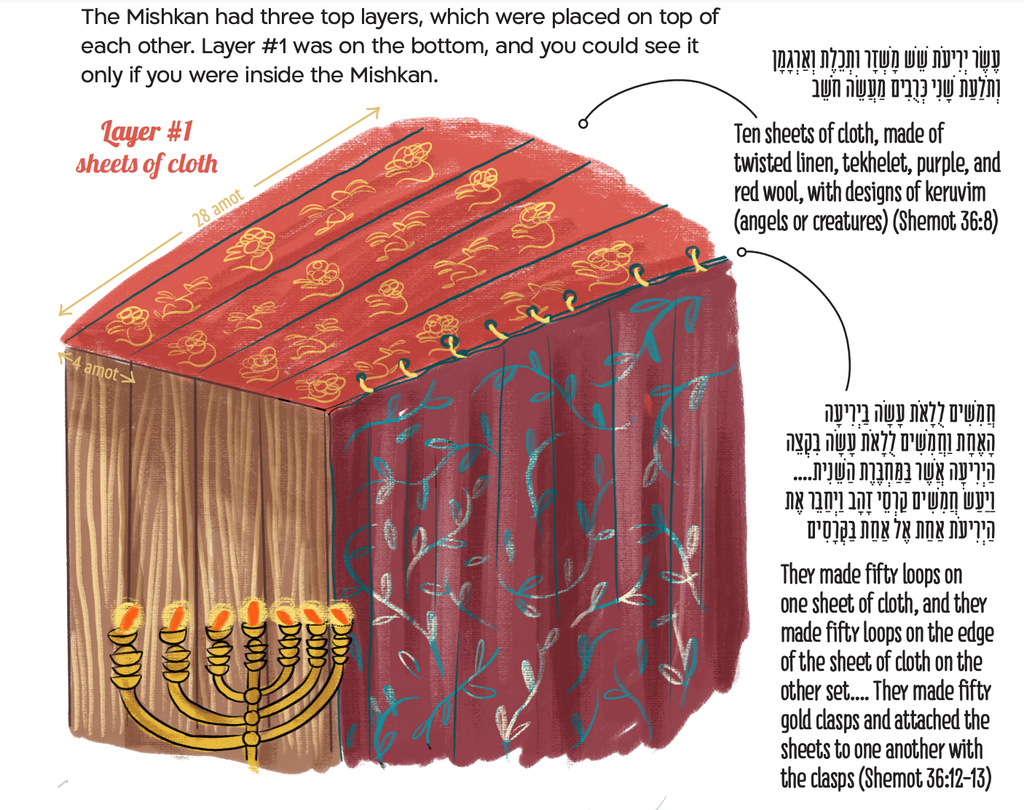
עֶשֶׂר יְרִיעֹת שֵׁשׁ מׇשְׁזָר וּתְכֵלֶת וְאַרְגָּמָן וְתוֹלַעַת שָׁנִי כְּרֻבִים מַעֲשֵׂה חֹשֵׁב
Ten sheets of cloth, made of twisted linen, tekhelet, purple, and red wool, with designs of keruvim (angels or creatures)
חֲמִשִּׁים לֻלָאֹת עָשָׂה בַּיְרִיעָה הָאֶחָת וַחֲמִשִּׁים לֻלָאֹת עָשָׂה בִּקְצֵה הַיְרִיעָה אֲשֶׁר בַּמַּחְבֶּרֶת הַשֵּׁנִית…. וַיַּעַשׂ חֲמִשִּׁים קַרְסֵי זָהָב וַיְחַבֵּר אֶת הַיְרִיעֹת אַחַת אֶל אַחַת בַּקְּרָסִים
They made fifty loops on one sheet of cloth, and they made fifty loops on the edge of the sheet of cloth on the other set…. They made fifty gold clasps and attached the sheets to one another with the clasps
layer 2: sheets of goats’ hair
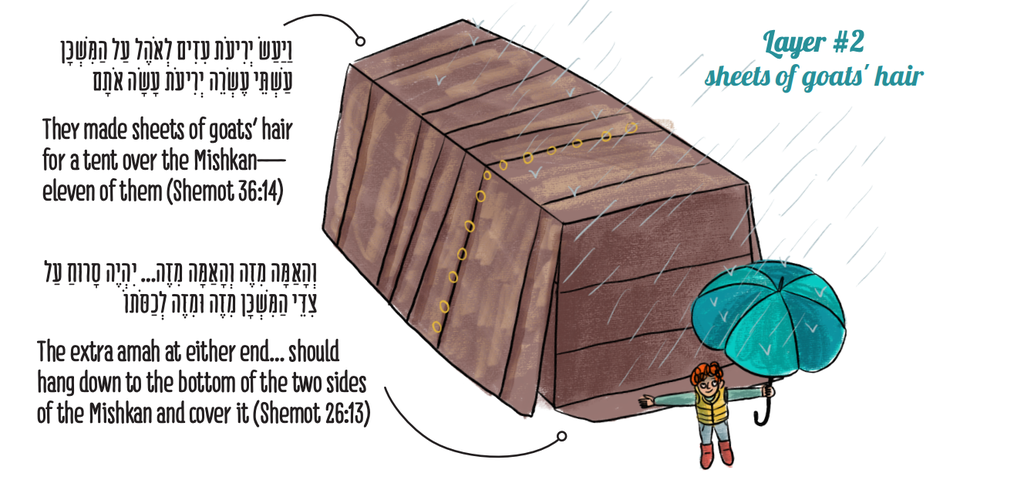
וַיַּעַשׂ יְרִיעֹת עִזִּים לְאֹהֶל עַל הַמִּשְׁכָּן עַשְׁתֵּי עֶשְׂרֵה יְרִיעֹת עָשָׂה אֹתָם
They made sheets of goats’ hair for a tent over the Mishkan—eleven of them
וְהָאַמָּה מִזֶּה וְהָאַמָּה מִזֶּה… יִהְיֶה סָרוּחַ עַל צִדֵּי הַמִּשְׁכָּן מִזֶּה וּמִזֶּה לְכַסֹּתוֹ
The extra amah at either end… should hang down to the bottom of the two sides of the Mishkan and cover it
Rashi says that we can learn a lesson from this second covering:
לִמְּדָה תוֹרָה דֶּרֶךְ אֶרֶץ שֶׁיְּהֵא אָדָם חָס עַל הַיָּפֶה.
The Torah teaches a rule of life: People should take care of beautiful things.
Covering #2 was like a raincoat. It protected covering #1, which was made from more beautiful materials and designs.
- Have you ever been worried that something beautiful that you made might get ruined? What did you do to protect it?
- What are some things you can do to protect beautiful things in our world?
- Why was it important for some parts of the Mishkan to be beautiful?
layer 3: animal skin cover
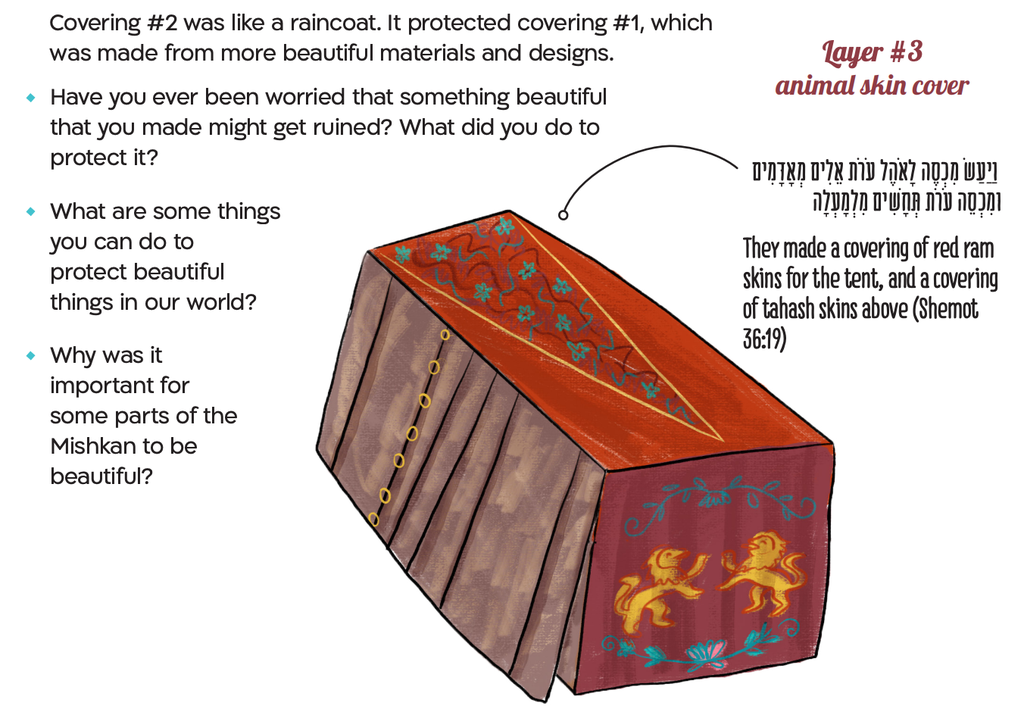
וַיַּעַשׂ מִכְסֶה לָאֹהֶל עֹרֹת אֵילִם מְאׇדָּמִים וּמִכְסֵה עֹרֹת תְּחָשִׁים מִלְמָעְלָה
They made a covering of red ram skins for the tent, and a covering of tahash skins above
We don't know exactly what these things looked like, but this is how R. Raphael Ricchi (300 years ago, Maaseh Hoshev, 4:7) thought it looked according to R. Nehemiah (Shabbat 28a).
What are עֹרֹת תְּחָשִׁים (tahash skins)?
Yerushalmi Shabbat 2:3 (4c) gives some possibilities.
- R. Yehudah: leather that was dyed violet
- Other Rabbis: skin of an unknown animal that lived in the wilderness
- R. Hoshayah: unicorn skin(!)
R. Avraham son of the Rambam says it could be a kind of embroidered leather.
Planks and Sockets
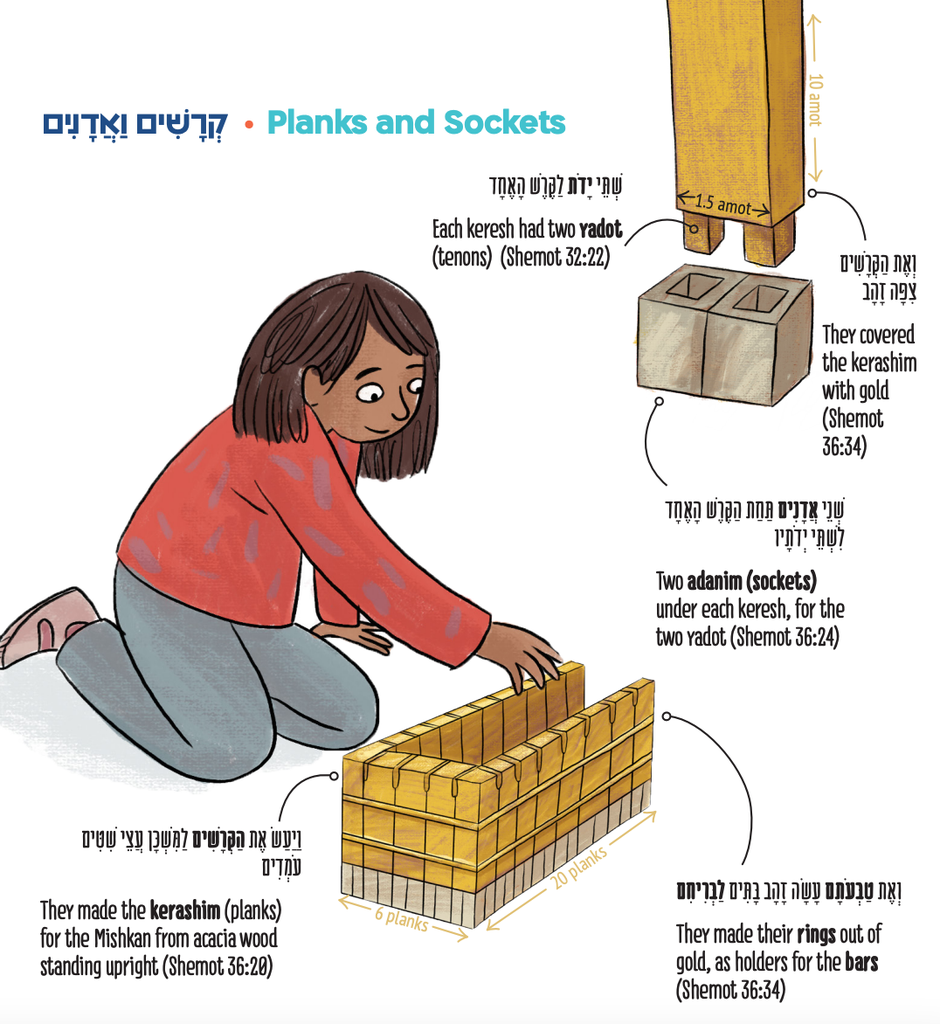
וַיַּעַשׂ אֶת הַקְּרָשִׁים לַמִּשְׁכָּן עֲצֵי שִׁטִּים עֹמְדִים
They made the kerashim (planks) for the Mishkan from acacia wood standing upright
וְֽאֶת־הַקְּרָשִׁ֞ים צִפָּ֣ה זָהָ֗ב וְאֶת־טַבְּעֹתָם֙ עָשָׂ֣ה זָהָ֔ב בָּתִּ֖ים לַבְּרִיחִ֑ם וַיְצַ֥ף אֶת־הַבְּרִיחִ֖ם זָהָֽב׃
They covered the kerashim with gold... They made their rings out of gold, as holders for the bars
שְׁתֵּי יָדֹת לַקֶּרֶשׁ הָאֶחָד
Each keresh had two yadot (tenons)
שְׁנֵי אֲדָנִים תַּחַת הַקֶּרֶשׁ הָאֶחָד לִשְׁתֵּי יְדֹתָיו
Two adanim (sockets) under each keresh, for the two yadot
Most of the supplies for building the Mishkan came from voluntary donations (Shemot 35:21-24). But the source of the silver for the adanim was different. This silver came from מַחֲצִית הַשֶּׁקֶל (mahatzit ha-shekel), a contribution of a half-shekel of silver that everyone was required to make (Shemot 38:25-28).
- Why is it important that the Mishkan’s supplies came from both optional and required donations?
- What's powerful about having one part of the Mishkan that everyone contributed to in exactly equal amounts?
פָּרֹכֶת וּמָסָךְ Parokhet and Masakh

וַיַּעַשׂ אֶת הַפָּרֹכֶת תְּכֵלֶת וְאַרְגָּמָן וְתוֹלַעַת שָׁנִי וְשֵׁשׁ מׇשְׁזָר מַעֲשֵׂה חֹשֵׁב עָשָׂה אֹתָהּ כְּרֻבִים
They made the parokhet (curtain) from tekhelet, purple, and red wool, and twisted linen—working it into a design of keruvim (angels or creatures)
וְהִבְדִּילָה הַפָּרֹכֶת לָכֶם בֵּין הַקֹּדֶשׁ וּבֵין קֹדֶשׁ הַקֳּדָשִׁים
The parokhet divides the Kodesh (Holy space of the Mishkan) from the Kodesh HaKodashim (Holy of Holies)
וַיַּעַשׂ מָסָךְ לְפֶתַח הָאֹהֶל תְּכֵלֶת וְאַרְגָּמָן וְתוֹלַעַת שָׁנִי וְשֵׁשׁ מׇשְׁזָר מַעֲשֵׂה רֹקֵם
They made the masakh (screen) for the entrance of the Tent, of tekhelet, purple, and crimson wool, and twisted linen, done in embroidery
- The parokhet and masakh hung on pillars, using hooks. The hooks are called וָוִים (vavim) because they are in the shape of a letter ו (vav).
The parokhet had a special design that wasn’t part of the masakh: keruvim. There were also keruvim in the design of the Mishkan’s top covering.
A few weeks ago, in Devash for Terumah, we described the keruvim that were gold statues on the כַפֹּרֶת (kaporet), which covered the אָרֹן (aron, ark). According to Rashi, the keruvim on the parokhet and on the Mishkan’s cover were creatures that were woven into cloth, like a tapestry.
What exactly did the keruvim look like? We don’t know! Rashbam thought they looked like birds (Shemot 25:18). Bekhor Shor writes that they looked like angels who look like cows (Bereishit 3:24). R. Abahu thought they looked like children (Sukkah 15b). Ibn Ezra says that the word “keruvim” could refer to any of these forms (Bereishit 3:24).
- Why might any of these forms fit nicely in the Mishkan? What might they represent?
כִּיּוֹר Kiyor
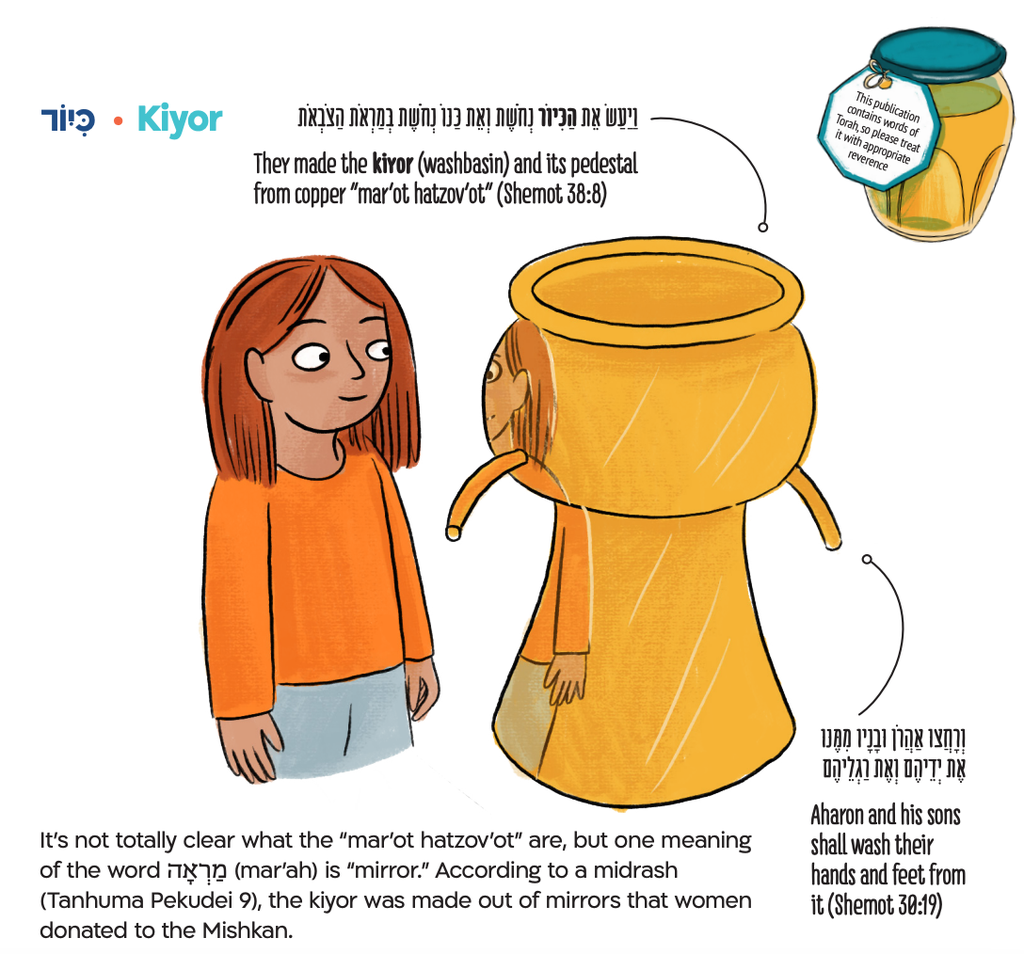
וַיַּעַשׂ אֵת הַכִּיּוֹר נְחֹשֶׁת וְאֵת כַּנּוֹ נְחֹשֶׁת בְּמַרְאֹת הַצֹּבְאֹת
They made the kiyor (washbasin) and its pedestal from copper “mar’ot hatzov’ot”
It’s not totally clear what the “mar’ot hatzov’ot” are, but one meaning of the word מַרְאָה (mar’ah) is “mirror.” According to a midrash (Tanhuma Pekudei 9), the kiyor was made out of mirrors that women donated to the Mishkan.
וְרָחֲצ֛וּ אַהֲרֹ֥ן וּבָנָ֖יו מִמֶּ֑נּוּ אֶת־יְדֵיהֶ֖ם וְאֶת־רַגְלֵיהֶֽם׃
Aharon and his sons shall wash their hands and feet from it
The kohanim used the kiyor to wash, and this could be the source for a kind of handwashing that we do today:
וּמִן הָעִנְיָן הַזֶּה תִּקְּנוּ רַבּוֹתֵינוּ נְטִילַת יָדַיִם לִתְפִלָּה.
Because of this, our Rabbis decreed handwashing before tefillah (prayer).
- In what ways is going to pray similar to what Aharon and the kohanim did?
- Look it up! In the pesukim about the kiyor in Shemot 30, the Torah emphasizes twice that washing with water from the kiyor will prevent death. What’s so important about washing hands before serving God that it’s literally the difference between life and death?
כֵּלִים נוֹסָפִים Miscellaneous Keilim
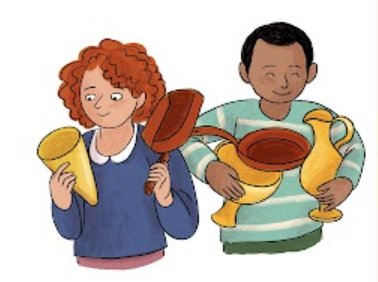
There was a lot more stuff that the kohanim needed for their work in the Mishkan! The Torah mentions that the שֻׁלְחָן (shulhan, table) and the מְנֹרָה (menorah) each had additional כֵּלִים (kelim, utensils) that went with them (Shemot 30:27). When discussing the מִזְבֵּחַ (mizbe’ah, altar), the Torah lists these small keilim as its accessories:
וְעָשִׂיתָ סִּירֹתָיו לְדַשְּׁנוֹ וְיָעָיו וּמִזְרְקֹתָיו וּמִזְלְגֹתָיו וּמַחְתֹּתָיו לְכׇל כֵּלָיו תַּעֲשֶׂה נְחֹשֶׁת
Make the pots for removing its ashes, as well as its scrapers, basins, flesh hooks, and fire pans—make all its keilim copper
Shadal (Italy, 200 years ago) explains the purpose of each of these.
- Scrapers - to gather ashes
- Basins - to receive blood
- Flesh hooks - to hang cut-up pieces of animals
- Fire pans - to rake coals and take them away
There are so many keilim—containers, tools, and vessels—in our lives. The many keilim in the Mishkan are supposed to teach us that we can use the tools around us to create holiness in the world. Zekharyah tells us that, one day in a more perfect world, even normal keilim that had nothing to do with serving God will become holy:
בַּיּוֹם הַהוּא יִהְיֶה עַל מְצִלּוֹת הַסּוּס קֹדֶשׁ לַה'
וְהָיָה הַסִּירוֹת בְּבֵית ה' כַּמִּזְרָקִים לִפְנֵי הַמִּזְבֵּחַ׃
וְהָיָה כָּל סִיר בִּירוּשָׁלִַם וּבִיהוּדָה קֹדֶשׁ לַה'...
On that day, horse’s bells will be holy to God, and the pots in the House of God will be like the basins before the mizbe’ah.
And every pot in Yerushalayim and Yehudah will be holy to God…
- This is the very last line of Sefer Zekharyah! What would it take to make every pot holy to God? How can we fill the keilim in our homes with holiness?
-------------------




